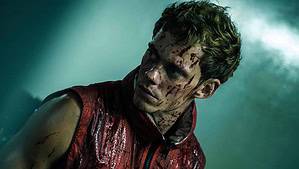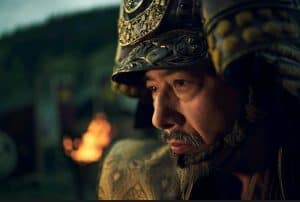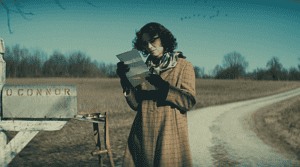This piece was written during the 2023 WGA and SAG-AFTRA strikes. Without the labor of the writers and actors currently on strike, the movie being covered here wouldn’t exist.
In the mid-’90s, rumors circulated that Princess Diana, the then-separated wife of Prince Charles, was dating John F Kennedy Jr., the heir to the Kennedy political dynasty. Whether it was true or not was beside the point. Two beautiful pop culture icons falling in love in the streets of New York? It was the perfect tabloid fantasy, rife with enough societal implications to fill the pages of People and Hello for weeks.
But, assuming it could’ve been true, how would it work practically?

Red, White & Royal Blue taps into the logistical hurdles and sweeping romance of a Diana and JFK Jr. pairing, with some tweaks. Prince Henry (Nicholas Galitzine) is the Diana stand-in, the stuffy but likable spare to the throne. (Someone refers to him as “Britain’s heart,” a pointed nod to the princess). Alex Claremont-Diaz (Taylor Zakhar-Perez) is our Kennedy surrogate, the US president’s playboy son with a keen political eye. Alex and Henry’s simmering, yearslong feud explodes at a royal wedding, with the pair covered in cake. To avert a diplomatic crisis, the president (Uma Thurman) forces Alex and Henry to become BFFs, at least in public. The ice eventually thaws between them, and sparks fly, as do the grim realities of a same-sex romance in the public eye. Alex and Henry must decide if their love can withstand the scrutiny and their own identity struggles.
Alex and Henry’s love might be a tabloid fantasy, but the circumstances are a nightmare. Red, White & Royal Blue, based on Casey McQuiston’s best-selling novel, has a deeply absurd premise, even by romantic comedy standards. There is no way a junior royal and the president’s son falling into an obscenely large cake would ruin British-American trade negotiations. The conceit nearly derails the film before it starts. The opening stretch carries a clumsy energy, as if it knows its set-up is ridiculous, which impacts everything from the performances to the quick-footed editing. Director and co-screenwriter Matthew López tries to stay true to the book, but the inciting incident doesn’t work well from page to screen.

Thankfully, López ditches the premise soon after, and we never hear it mentioned again. Freed from those narrative bonds, the film comes to life. Alex and Henry are a dynamic pair, a near-flawless spin on the “enemies to friends to lovers” trope. The polar opposites have a charming and inviting rapport, teasing, challenging, and surprising each other every chance they meet. We see their long-distance connection blossom in unexpectedly creative ways, like a WhatsApp call about a Thanksgiving turkey staged as pillow talk in the same bed. (The movie could’ve used that visual motif a lot more.) By the time they share their first kiss — an exasperated expression of their growing bond and mutual fear of its meaning — you are firmly in their corner.
Red, White & Royal Blue is surprisingly broad in capturing Alex and Henry’s complex relationship. The film explores everything from electoral politics and the monarchy’s modern relevance to tabloid culture and the coming out process. The themes’ success depends on their close proximity to the romance. The discussions around sexual identity, tabloid culture, and privacy ring true because it directly impacts their relationship. (Alex’s bisexuality, framed as another dimension of his identity, is a welcome surprise.)

The plot points that don’t directly impact them feel like distractions. Alex’s political aspirations lack stakes in his relationship, either as an obstacle or a source of inspiration for Henry to combat his struggles. The prince’s isolation within the monarchy weighs on the couple, but we see little of his public role. The absence – quite glaring compared to Alex’s voter registration exploits in Texas – makes the prince’s pain frustratingly opaque.
The film succeeds by focusing on Alex and Henry’s naughty but heartfelt connection. López balances the silly and sincere well, knowing when to lead gentle intimacy over the cheeky banter and vice versa. The film is quite funny, landing both heartwarming chuckles and belly laughs from even the most obvious jokes. That charming humor bolsters the intimate and dramatic moments when the couple lowers their guards and reveal their truest selves. The cheesy dialogue is easily forgivable because of how successfully it lands. The film shines when both modes work together, as in Alex and Henry’s first real love scene. The revelatory moment, rife with horny teasing, cute nervousness, and tender affection, confirms Alex and Henry have something special.

It helps that Nicholas Galitzine and Taylor Zakhar-Perez are as endearing as their characters. They have excellent chemistry, possessing an effortless rapport that easily transforms as they bicker, make out, and confess their characters’ deepest feelings. Galitzine yearns beautifully through his eyes, and his palpable ache powers the film’s most emotionally affecting scenes. Zakhar-Perez doesn’t quite share his partner’s dramatic ease, but his naughty charisma earns every smile. The two lift each other to form one of the year’s most likable on-screen romances. Zakhar-Perez and Galitzine are great, but Sarah Shahi nearly steals the film as Zahra, the harried, take-no-prisoners presidential aide. Her exasperation with the shenanigans forced upon her is hilarious, and she lands many of the biggest laughs.
If Henry and Alex are Gen Z’s Diana and John-John, Red, White & Royal Blue makes a compelling case for them. Even without the ‘90s reference, the film is a saucy, enchanting rom-com that wraps queer love in a fluffy fantasy. (The kind of fantasy that straight couples have enjoyed for over a century.) An older, naughtier cousin to Heartstopper, Henry and Alex will make you believe that love triumphs all, even anachronisms like the Electoral College and the British monarchy.
Red, White & Royal Blue will premiere exclusively on Prime Video on August 11, 2023.
If Henry and Alex are Gen Z’s Diana and John-John, Red, White & Royal Blue makes a compelling case for them. Even without the ‘90s reference, the film is a saucy, enchanting rom-com that wraps queer love in a fluffy fantasy.
-
GVN Rating 7
-
User Ratings (2 Votes)
7.5
A late-stage millennial lover of most things related to pop culture. Becomes irrationally irritated by Oscar predictions that don’t come true.







